The good news this morning is that Sean’s paper describing the new method he’s developed to reconstruct palaeoclimate using data assimilation techniques has been published (open access, of course) In the Journal of Advances in Modeling Earth Systems: https://agupubs.onlinelibrary.wiley.com/doi/full/10.1029/2019MS001630 The method produces spatially explicit maps of seasonal palaeoclimate variables from site-based reconstructions and a model-based prior, but is not constrained to reproduce the “climates” seen either by the data or the model. Sean has applied this method, as a proof of concept, to southern Europe at the LGM. Now to conquer the world!
The response of the journal to this paper was interesting – they really embraced the idea of this paper after they got the message that this was really a mathematically based approach rather than a statistical correlation technique. So, I guess that means that someone accepts the idea that knowing about palaeoclimate is really something that will lead to advances in modelling earth systems.
The JAMES paper is Dr Cleator’s first post-being doctored publication. In the flurry of things happening before Christmas, we didn’t get around to celebrating the fact that Sean successfully defended his thesis and is now Dr Cleator. So double congratulations Sean!


